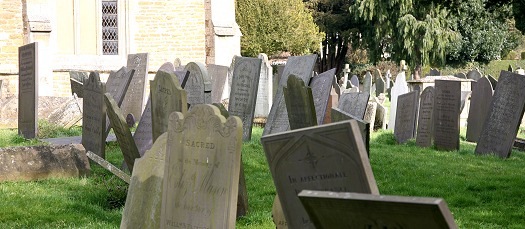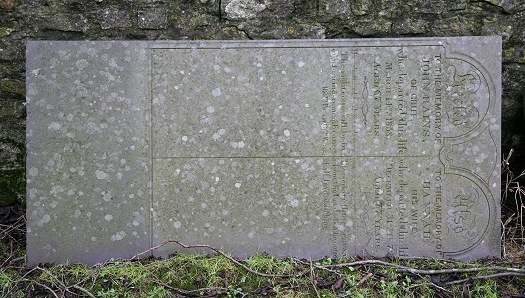Poor Frank Raw

Home | Church list | Blog posts | Why PoorFrankRaw? | Contact | Shop
What Lies Beneath?
Posted 28/09/2015 (Update 01/12/2023)

Churchyard memorials come in a variety of shapes and styles, but just for a moment let's consider the regular sort, a vertical stone at the head of a grave. Older upright stones will probably be partly embedded in the ground - a single flat slab of stone.
What do you see? Well there's an area for some lettering, maybe a bit of carving - perhaps an angel or two or a nice Memento Mori skull and bones. Down towards the ground the area set aside for lettering may have a frame or border, or the flat surface may just run straight down beneath the turf.
But what lies below the turf? Clearly the stone needs to be set far enough into the earth so it remains upright. Roughly a quarter below ground seems to be typical, among the uprooted stones I've seen.
When a stone has been in situ for a long time the soil can move - tree roots move things around, the underlying soil might move in dry or wet weather and eventually a stone might start to lean over to the point where it falls, or is lifted and laid flat before gravity takes it down.
At that point we get to see the part of the stone which was never meant to be seen. And sure enough, often there is... nothing to see. This is one of several at Holy Trinity, Middleton, Derbyshire, propped against the churchyard wall, awaiting (hopefully) resetting:

The part of the headstone below the surface, especially on earlier stones, pre-mechanisation, may not be so finely prepared as that above ground. It might be little more than rough chiseled rock, but as long as the visible part is nicely worked, then all is well.
And that part of the stone below ground... if you wanted to try out a letter, test a chisel after sharpening, allow your apprentice to make a few practice cuts, what better place because stone is stone and this will never be seen.
Until the day when it is seen.
 A small example first, at St Michael, Kniveton, Derbyshire. A headstone has been temporarily laid flat on top of a box tomb and the underground portion is visible. On a flattish part of the rough hewn slate is a solitary, clumsy letter P, and a couple of practice cuts.
A small example first, at St Michael, Kniveton, Derbyshire. A headstone has been temporarily laid flat on top of a box tomb and the underground portion is visible. On a flattish part of the rough hewn slate is a solitary, clumsy letter P, and a couple of practice cuts.
Slightly further south at St Alkmund, Duffield, two stones, side by side - now laid flat but both previously upright. The first again has a solitary, partly formed P, near the bottom of a very random shaped subterranean section.
 But the second stone is littered with cuts, letters, something like a swastika and has clearly been around the workshop for quite a while, being used as a scratch-pad.
But the second stone is littered with cuts, letters, something like a swastika and has clearly been around the workshop for quite a while, being used as a scratch-pad.
Did the letter carver try a couple of cuts every time the chisel was sharpened? Or was an apprentice busy practising  letters in between the more lowly tasks for a new boy - carting stone and roughing out pieces to be cut into headstones?
letters in between the more lowly tasks for a new boy - carting stone and roughing out pieces to be cut into headstones?
As so often, we can't see into the past with sufficient clarity to know what happened and why, but what an intriguing glimpse into the workshop of Mr Richard Marshall, 200 years ago.
 I found just one example at Edward the Confessor, Leek, Staffordshire. A couple of more or less complete letters - though the bottom of the T is rather strange, and a zero or maybe an O.
I found just one example at Edward the Confessor, Leek, Staffordshire. A couple of more or less complete letters - though the bottom of the T is rather strange, and a zero or maybe an O.
The last example is not a cut letter, but it does raise a question about tools. How were letters on headstones marked out in the late 18th century? Now we use hard black pencils (9H is common), hard white pencils, or you can draw out your design on paper and trace it down onto the stone using carbon paper.
A leading pencil manufacturer tells us that mass production of pencils began in Nuremburg in 1662 but did the average letter carver in 1800 have a ready supply of good hard pencils, suitable for writing on stone? I doubt it. More likely is that letter carvers either worked freehand, perhaps with some scribed horizontal lines as a guide, or laid out their letters with a brush and ink or paint.
 Fr Edward Catich, referenced here in this fascinating article by John Nash, said the Romans marked out their inscriptions with a brush and this was part of the reason for the development of the serif on Roman letters.
Fr Edward Catich, referenced here in this fascinating article by John Nash, said the Romans marked out their inscriptions with a brush and this was part of the reason for the development of the serif on Roman letters.
So here we have my last example of an underground letter. This stone, dated 1787, was leaning on a wall at St Peter, Ellastone, Derbyshire, showing a single capital B, in ink. The letter is about 3cm high and appears to have been drawn with a brush.  Assuming the letter is indeed from the date on stone, clearly the ink was of high quality to survive underground for so long.
Assuming the letter is indeed from the date on stone, clearly the ink was of high quality to survive underground for so long.
The letter isn't perfect in its form, so may have been the work of an apprentice, your guess is at least as good as mine.
So the next time you see a headstone uprooted, take a close look at its underskirts and if you see any letters, let me know!
Update
Some churches decide to clear all the headstones from their churchyard, for easier maintenance (mowing) or to create a space for some other activity. This can be done in a sympathetic way or it can be done such that it makes a churchcrawler weep. Loughborough, All Saints is in the latter category.
The silver lining to that heinous, Philistinic cloud, is the ability to see the parts of headstones which otherwise would be underground. Here are some examples from Loughborough (click the thumbnails for larger versions):













